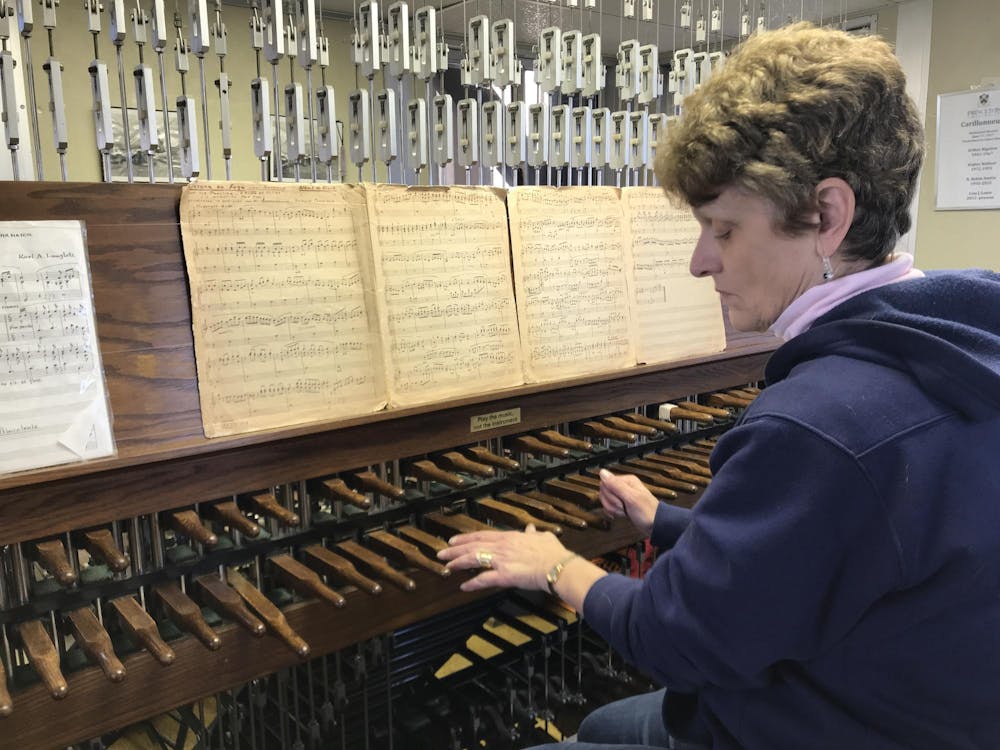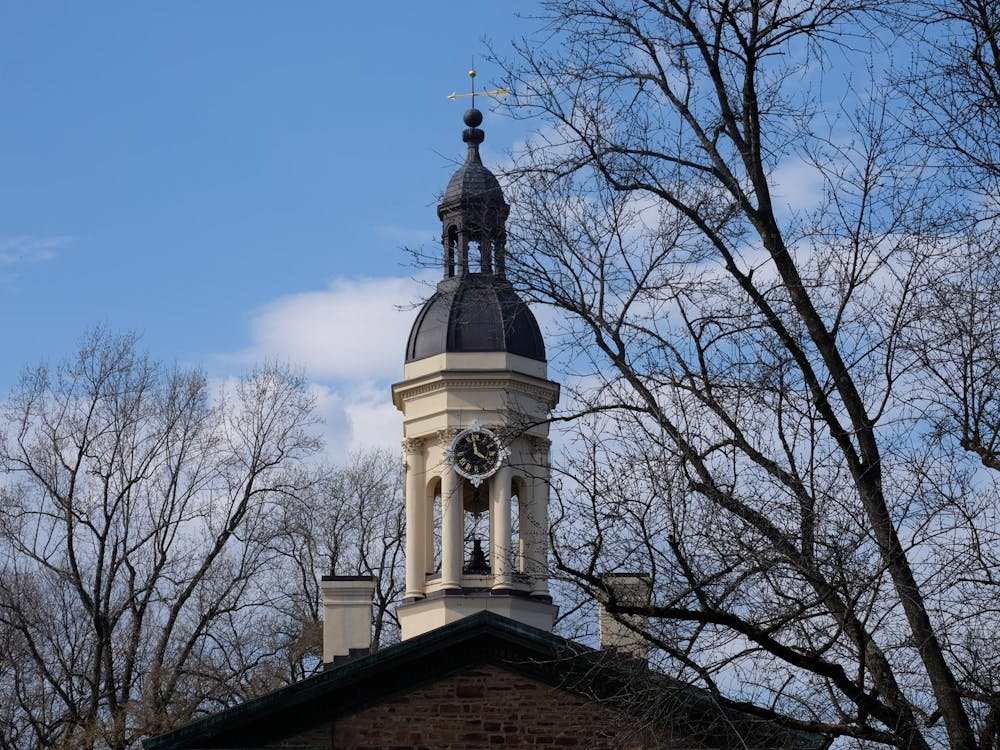Any Forbes frequenter knows its sound, but few know its story. Crowning the Cleveland Tower of the Princeton Graduate School is the campus carillon, a keyboard-based percussion instrument that commands twenty tons of bronze bells.
Each Sunday, University Carillonneur Lisa Lonie sets aside her fear of heights and climbs 137 spiraling stairs up to a confined console room. There, she employs all four limbs to play a repertoire that ranges from Elizabethan-era melodies to Miyazaki soundtracks.
In talking with Lonie and other members of her carillon community, one thing is clear: “bell fever” is real, and it’s contagious.
Lonie is doing her part to help its spread. As Princeton’s carillonneur, she performs on campus every Sunday, teaches lessons, and organizes the University’s summer carillon concert series.
Princeton is just part of the picture for Lonie. She also arranges music for the carillon, serves on several sub-committees of the Guild of Carillonneurs in North America, instructs for the North American Carillon School, and heads the carillons of the Church of the Holy Trinity in Philadelphia and the St. Thomas Church in Whitemarsh.
These musical endeavors all come on top of her day job as assistant chief of staff at Haverford College.
“I don’t know anybody busier than Lisa Lonie,” former University Carollineur Robin Austin told The Daily Princetonian.
In addition to juggling a tight schedule — a standard Sunday for Lonie starts with a morning church performance before taking the Pennsylvania Turnpike north to Princeton, performing there at 1 p.m., then teaching — Lonie must also navigate the distinct challenges posed by the carillons themselves. She explained that every instrument is unique in its number of bells, arrangement of keys, and overall sound. These differences require adaptability.
“Every time you sit on a carillon, you have to compensate,” said Lonie. “It keeps you on your toes.” When she plays at Princeton after performing at one of her churches, she starts with “Old Nassau” and then another familiar song to give herself time to adjust.
Lonie’s locations also have different demands programmatically. She jokes that “the back of [her] car looks like a music library,” with a pile of sheet music for each instrument she plays. Beyond the logistical matter of which songs can be played on Holy Trinity’s 25 bells versus Princeton’s 67, there’s the matter of matching the setting.
She might play music from “Howl’s Moving Castle” or “Game of Thrones” at Princeton but not at her churches, and vice versa for hymns. Lonie said she aims for her Princeton repertoire to include songs the student body will recognize.
This succeeded with Madeline McDonald ’26, who described hearing a carillon rendition of a Beatles song while eating in the Forbes backyard one day. “I kind of wasn’t expecting to recognize any pieces,” she said. As a Beatles fan, she was struck.

That day was the start of a long-lasting passion for McDonald. After noticing a human figure in the sky-filled gap of the carillon’s silhouette and realizing that the bells were not automated as she had originally assumed, she found Lonie’s contact information online and reached out.
McDonald went on to profile Lonie for her journalism class and make a short film called “The Bellmaster” for her documentary class. She received a Director’s Choice Award at the Thomas Edison Film Festival and a Jury’s Choice Award at the New Jersey Young Filmmakers competition. Since then, McDonald has been developing the concept for a feature film about the carillon’s history, with a dedicated moodboard that fills up the better part of her dorm wall.
“I’ve become kind of bell crazy,” she said. “I need to tell this story.”
Lonie’s musical exploration extends beyond 60’s rock — and she has embraced collaboration. “The carillon is a percussive instrument, and it plays well in the musical sandbox with other instruments,” Lonie explained.
She has brought other musicians specializing in guitar, mandolin, brass, oboe, and vocals into the tower to perform with her, where she streams a video feed online. She has also worked with Ph.D. composition students and Princeton Laptop Orchestra to produce electroacoustical music, in which electronic tracks are layered over Lonie’s music and projected through 900-watt speakers.
“The electroacoustical music is really exciting for me, because it’s taking this instrument which is grounded in medieval Europe and … smashing it into today,” Lonie said.
Her effort to widen the carillon’s horizons has also taken on a multicultural dimension, with the goal of making the “very public instrument more diverse and more equitable.” Lonie’s “Music that Reminds You of Home” series encourages students to send in songs from their respective countries, which she then arranges and performs on the carillon. The initiative has added songs from China, Singapore, Taiwan, and more to Lonie’s repertoire.
The carillon’s ability to “cut across all lines” — and to send its sound out for a quarter or half mile in all directions — is part of what makes it “democratic,” Lonie noted. “You don’t need a ticket … you just come with your lawn chair or your blanket.”
Its wide reach and accessibility made the carillon concert experience and ideal cultural outing during COVID-19, said Lonie. She expressed gratitude that the Princeton carillon continued hosting performances during the pandemic.
It was during the pandemic that Rutgers Professor of Material Sciences and Engineering Dunbar Birnie first listened to one of Lonie’s concerts. He has since attended her Princeton performances rain or shine, where he often runs into other regulars he’s now able to identify merely by their jackets or cars.
Birnie described the performances as a “meditative time.”
To that end, two years ago, Lonie began a habit of finishing her Princeton performances with a “What a Wonderful World.” The song serves both as a signal of her conclusion and as a “way of communicating that it is a wonderful world … [and that] everything’s going to be okay.”
“There’s something about — even if you’re just strolling around or sitting on that picnic blanket — the breeze on your face, the sun on your back, and hearing the carillon,” Austin said. “I think it appeals … [to] something deep within us.”
By his estimate, “Princeton University has one of the most beautiful carillons in the world. That’s not just because I was affiliated with it.”
“I mean, conservatively, one of the top 10 instruments in the world. [In] my opinion, one of the top three or four,” he continued. “I can’t emphasize that enough. The location, the tower — because the entire tower is an antiphonal chamber … it’s got everything going for it.”
Princeton chemistry Ph.D. candidate James Cox described the instrument as “majestic.” Though Cox came to Princeton without any knowledge of the school’s carillon or how to play it, his appreciation for the instrument prompted him to start taking lessons with Lonie, which he has continued over the course of his five years on campus.
Like other students, Cox started in the practice room in the graduate college basement, which features a mock carillon fitted with tone bars rather than bells. He now plays regularly at Princeton and various other locations, including in his home state of Minnesota.
For Cox, part of the “irresistible appeal” of the instrument is its history. The Princeton carillon’s past resounds in its musical and physical contours. The Renaissance tunes in Lonie’s repertoire, the archive of sheet music and University Carillonneurs displayed on the console room’s yellow walls, and the collection of past summer concert series posters filling the practice room all testify to the carillonneur’s participation in a deeply rooted legacy.
Lonie pointed out that Princeton icons like Einstein and Oppenheimer would have heard the same carillon as listeners today.
The Princeton carillon’s origin is particularly storied. According to Lonie, urban legend has it that the Class of 1892 had paid for the bells and sent them on their way from England to Princeton as a gift in 1926, in honor of their 35th Reunion — all before telling the University’s Board of Trustees what they had done. The first Princeton carillonneur, Arthur Bigelow, added 14 bells of his own design some years later and made plans to re-scale the treble register, but the instrument fell into disrepair after his passing in 1967.
Austin and a committee of devotees worked to raise funds for renovations in the early 1990s, and Austin was appointed carillonneur in 1993. Upon his departure in 2012, Lonie was hired, and she’s been pushing the envelope since.
The stakes are high. Lonie noted that there’s no way to prevent a wrong note from reaching its half-mile-away audience once it’s been played. And because that audience can’t typically see her, McDonald commented, the people who benefit from Lonie’s performances “don’t [always] know where to direct their gratitude.” Lonie calls her music “the largest sound on campus that nobody knows about.”
“I love what I do. I just love what I do,” Lonie said. She shared the hope for “anybody in the community and at the University … [to] hear the instrument [and] take it with you [as a] part of your experience at Princeton.”
“I think it’s a really beautiful, humble, and generous thing for her to spend so many years up in the tower — and also passing on this craft to future generations of bell players,” commented McDonald. “She really, really cares about the students.”
“Often we say among those who play the carillon [that] it chooses us,” noted Austin.
Between Birnie’s commitment as a listener, McDonald’s passion as a documentarian, Cox’s fascination as a learner, and Lonie’s own dedication to the instrument, it seems safe to say that she was indeed chosen.
Helena Richardson is a contributing Features writer for the ‘Prince.’
Please direct corrections requests to corrections[at]dailyprincetonian.com.








